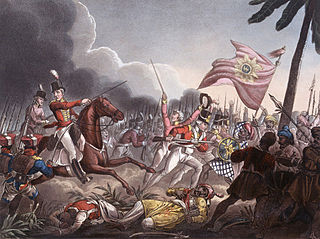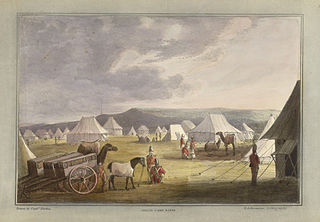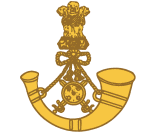Anglo-Maratha Wars may refer to:

The Maratha Confederacy, also referred to as the Maratha Empire or the Maratha Kingdom, was an early modern polity in the Indian subcontinent comprising the realms of the Peshwa and four major independent Maratha states who were often subordinate to the former. It was formed in 1674 with the coronation of Shivaji of the House of Bhonsle as the Chhatrapati of the Marathas. The Maratha realm was recognised by Bahadur Shah I, the Shahenshah of Hindustan as a tributary state in 1707 after a prolonged rebellion. The Marathas continued to recognise the Shahenshah as their nominal suzerain similar to other contemporary Indian entities.
Mahratta may refer to:
Maratha are a Marathi-speaking people from Maharashtra, India.

The Second Anglo-Maratha War (1803–1805) was a large conflict within the Maratha Confederacy involving the British East India Company. It resulted in major loss of territory for the Marathas, including regions around Delhi and in present-day Gujarat falling into direct Company rule.

The Third Anglo-Maratha War (1817–1819) was the final and decisive conflict between the British East India Company and the Maratha Empire in India. The war left the Company in control of most of India. It began with an invasion of Maratha territory by British East India Company troops, and although the British were outnumbered, the Maratha army was decimated. The troops were led by Governor General Hastings, supported by a force under General Thomas Hislop. Operations began against the Pindaris, a band of Muslim mercenaries and Marathas from central India.

Asirgarh Fort is an Indian fortress (qila) situated in the Satpura Range about 20 kilometres (12 mi) north of the city of Burhanpur, in the Indian state of Madhya Pradesh. The Asirgarh fort is said to have been built by a king named Asa Ahir in the early 15th century. Because the fortress commands a pass through the Satpuras connecting the valleys of the Narmada and Tapti rivers, one of the most important routes from northern India to the Deccan, it was known as the "key to the Deccan".

The First Anglo-Maratha War (1775–1782) was the first of three Anglo-Maratha Wars fought between the British East India Company and Maratha Confederacy in India. The war began with the Treaty of Surat and ended with the Treaty of Salbai. The war, fought in between Surat and Poona, saw British defeat and restoration of positions of both the parties before the war. Warren Hastings, the first Governor-General of Bengal decided not to attack Pune directly.
Indian War may refer to:
First War may refer to:

The Maratha Light Infantry is a light infantry regiment of the Indian Army. It traces its lineage to the Bombay Sepoys, raised in 1768, making it the most senior light infantry regiment in the Indian Army.

The Battle of Khadki, also known as or the Battle of Ganeshkhind and Battle of Kirkee took place at modern day Khadki, India, on 5 November 1817 between the forces of the British East India Company and the Maratha Confederacy under the leadership of Appasaheb Bhonsle. Company forces achieved a decisive victory, with Khadki later becoming a military cantonment under British rule.

The 105th Mahratta Light Infantry were an infantry regiment of the British Indian Army. The regiment traces their origins to 1768, when they were raised as the 3rd Battalion, Bombay Sepoys.
Pettah may refer to:
Mahratta War may refer to:
The Capture of Hooly Honore, a town and fortress held by forces of the Kingdom of Mysore, occurred on 21 December 1791, after two days of siege by combined forces of the British East India Company and the Maratha Confederacy. The battle was part of a campaign during the Third Anglo-Mysore War by Maratha leader Purseram to recover Maratha territories taken by Hyder Ali in an earlier conflict between Mysore and the Marathas.
The Maratha–Mysore wars were a conflict in the 18th century India between the Maratha Confederacy and the Kingdom of Mysore. Though initial hostilities between the sides started in 1760s, the last battle began in February 1785 and ended in 1787.

The Maratha Army was the land-based armed forces of the Maratha Confederacy, which existed from the late 17th to the early 19th centuries in the Indian subcontinent.
Battle of Delhi may refer to:
Handia is a village in Madhya Pradesh state of India. It is located in the Handiya block and tehsil of the Harda district. Handia is located on the left bank of the Narmada river; Nemawar is located on the opposite side, which belongs to Dewas district.

The Maratha–Portuguese War of 1683–1684 refers to the Mahratta invasion of the Portuguese-controlled portions of Goa and the Bombay area of coastal Konkan. The conflict between the Mahratta Confederacy and the Portuguese in Goa and Bombay, continued on various fronts in between 1683–1684.